Leaden Hall was our destination. Once an MOD bombing area and concreted over, it was returned to grassland in 1991 and now thrives as a target for Hen Harriers, Merlin, Great Grey Shrike and many other species.
These we had hopefully come to see as Autumn and Winter are the times to spot them here.
We parked at Deadman Hill and walked down into Black Gutter Bottom, then up the opposite side to Leaden Hall's plateau. The temperature gauge in my van had read zero degrees. The wind was a slight crisp northerly so we were glad we were wearing our thermals.
The sun was just lifting from the horizon as we reached the summit and it lit up the slight frost and gradually began to melt it.
I love being awake at sunrise. The long shadows, stillness and remoteness of this place transported us away from the humdrum working week into relaxation in Nature.
The frost had reverted back to dewdrops.
All around us in the scrub and trees, Fieldfare, along with some Blackbird, Song Thrush and an occasional Redwing gorged themselves on the fruitful bounty.
One Fieldfare posed calmly for us in the golden sunlight.
A constant flow of Gulls, mainly Herring, headed West to East as we walked. Clearly on a mission to their feeding grounds out of their roosting site which we concluded was from Blashford Lakes in the West.
Having drawn a blank on any raptors other than a passing Kestrel and very distant Goshawk, we continued past Ashley Hole and onto Cockley Hill.
The Forest has a strange way of throwing up birds that you wouldn't expect to see here. One being the Reed Bunting. We saw several here on this day.
and a few Bullfinch too. This one sculked out of sight so this was the best I could muster. One day I will capture this enigmatic little bird in a more deserving pose.
I scanned the area through my binoculars and found one of our target birds, The Great Grey Shrike.
This one gave us some wonderful views, so we indulged with one or two shots!
We followed it as it hunted and no matter where we seemed to walk, it had a knack of appearing close by. We headed back towards Leaden Hall. In my mind I just knew we would see it there. As we turned the corner onto the plateau once more, there it was, such a magnificent bird!
As we began our walk back to the cars we discussed our disappointment in not seeing a Hen Harrier or Merlin and decided on our next move. It was only 11.30 so we agreed to head back East and Farlington Marshes, there be Owls there!
A fairly easy journey along the M27 and a very tight squeeze getting my van under the height restriction at the Farlington Marsh car park. We set up our gear and walked the sea wall into the main reserve. Above us the unmistakable silhouette of a Sparrowhawk patrolled the area.
Farlington is a peninsular next to Portsmouth with a mixture of grassland, marsh, pools and scrapes that is perfect for a myriad of species. One in particular being the Short Eared Owl. It visits here this time of year and usually spends the Winter here in reasonable numbers.
As we headed to the southern tip we stopped off by the lake. It was almost high tide so the Wading birds were heading in to roost on the inland water.
Some Black Tailed Godwit were already taking a well earned nap...
Only to be occasionally disturbed by an alarm call, whether false or not.
The Teal remained calm and aloof regardless....
There were two Kestrel hunting nearby. One gave reasonable views for my camera..
Brent Geese numbers were rising here also. They begin to arrive at the end of September and are not unknown come April.
We were nearing Point Field on the most southerly tip. A notorious area to see the Owls but we hadn't seen one so far. Only news from another that they had been out hunting in the morning.
That is the joy of these Owls, they hunt during the day!
We had a choice...Continue along the seawall or cut across through Point Field?
Our choice was made by the call of a very tiny warbler..the Dartford Warbler. We descended into the field.
This beautiful little creature is a resident species here and one success story when so many are in decline. Recent years have witnessed a resurgence in numbers due in no small part to the conservation and regeneration of habitat where it can thrive. We have the fortune to see it regularly along the South Coast and I for one never tire of seeing and photographing this little gem, no matter how challenging it may be. In Spring and Summer it sits aloft on the brambles...in Winter it skulks away giving only brief glimpses, so a keen eye and a sharp trigger finger is required!
The Warbler disappeared but as we continued to survey the area I noticed a strange looking clump of grass...it had eyes. I called to Chris. I'd found our first Owl!
Then not six feet away, another!
Then Chris spotted a third, we were in a Short Eared Owl minefield, fantastic!!
We froze in case there were more but it seemed 3 were the total.
They roost on the ground so we waited for them to fly and hunt. We didn't have to wait long as one became restless and departed, then another. The last decided to stay, so we eventually went in search of the hunting duo.
We found them easily on the main marsh viewed from the sea wall. They fly lazily looking for rodents and quite often sit on the ground awaiting their next move...
Distracted from the Owls, a group of Shoveler Duck flew over. This male showing it's extraordinarily large bill as it headed into the setting sun
Portsmouth and the Spinnaker Tower showed well on the opposite peninsular.
Flocks of Dunlin began to settle to roost as the tide rose. Where a few weeks ago there were few, now they numbered in their hundreds
Back on the marsh, the Owls continued to enthrall...
They like to sit upon anthills and survey the area. This one made a leap and clearly found a tasty vole which it despatched swiftly...
By this time the third had joined the fray and as the sun set it gave a wonderful backlight to the scene.
Another wonderful sunset. I couldn't believe it was just 9 and a half hours after the sunrise in the New Forest. We had packed so much into one short day.
I saw one Owl heading off with a vole clutched beneath it. One hell of a view before the end of it's life, the ultimate terminal theme park ride!
Chris had to head home at this point but I craved more before the sunset so I headed back to Point Field for the last time. The light was diminishing so the shots were a little more grainy but with two Owls hunting around my head I couldn't care less!
It was near dark so I walked back along the seawall to the van watching the Dunlin fly to roost as I did so.
As I passed the lake, my final shot was of a Black Tailed Godwit still feeding on the shore. The days are getting shorter so they need every moment to feed to survive to make it through the cold nights. I couldn't imagine how it must feel to spend the night here as I headed back to my heated home. Makes you thankful for small mercies.
N.B. The title of this post is taken from the song...'Sunrise,Sunset' from the film 'Fiddler on the Roof' and also made popular by Perry Como.













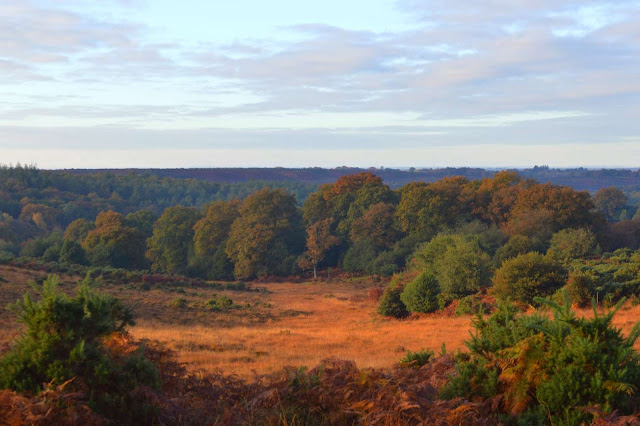














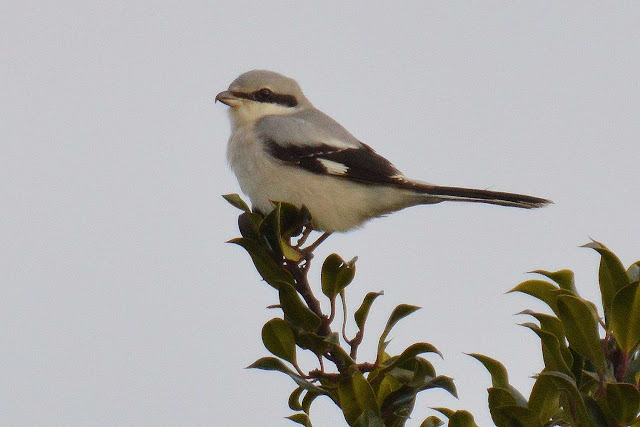
























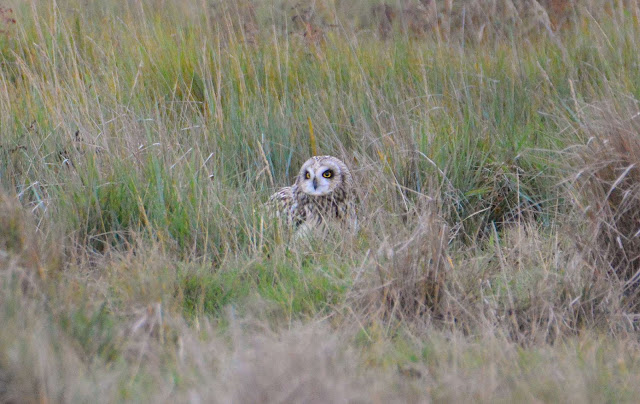

















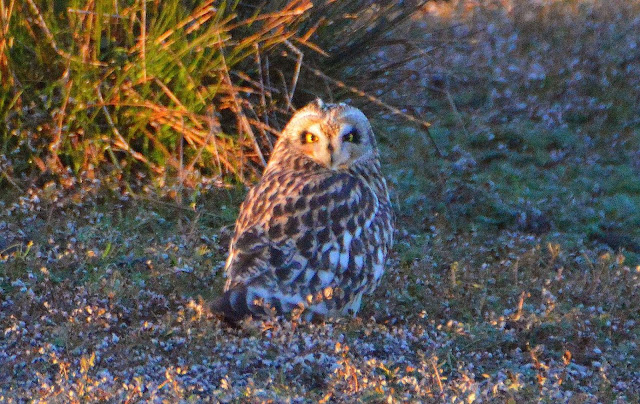






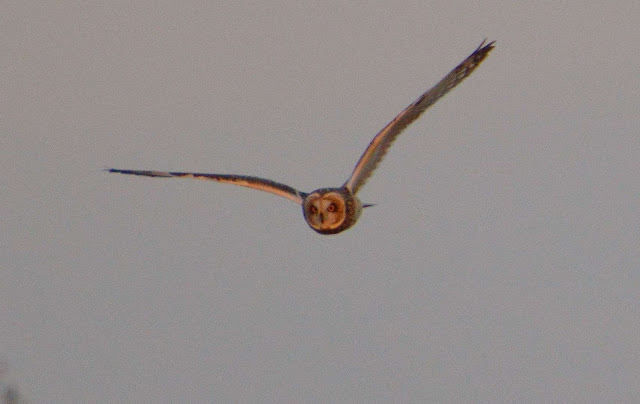




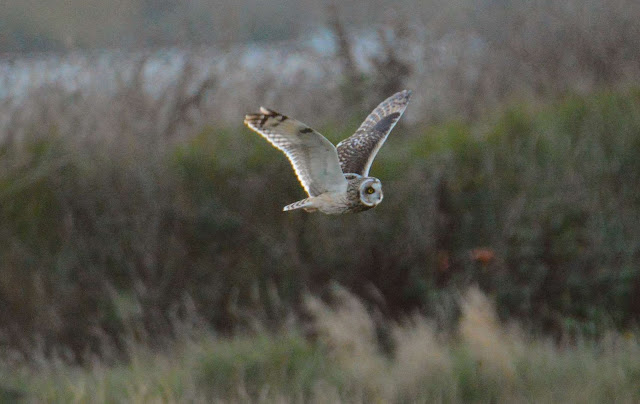






No comments:
Post a Comment
Please leave me a message if you would like to do so.